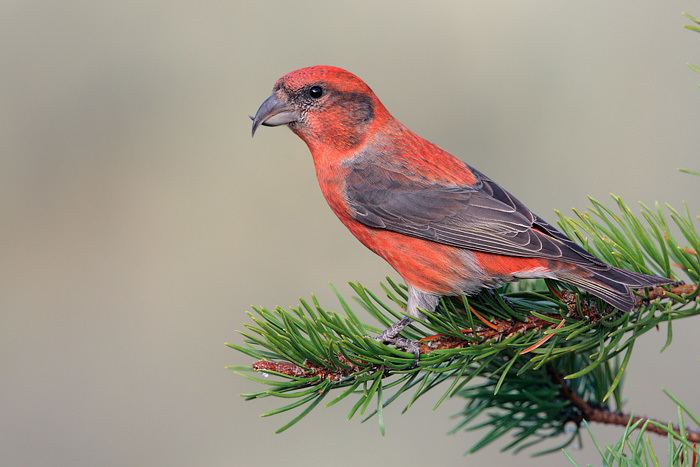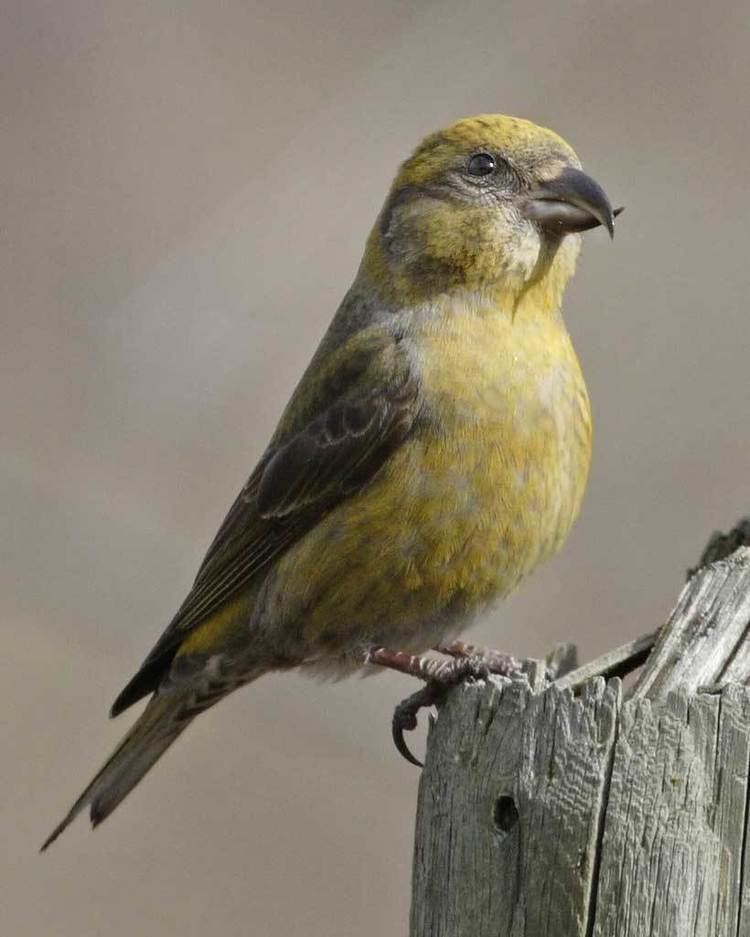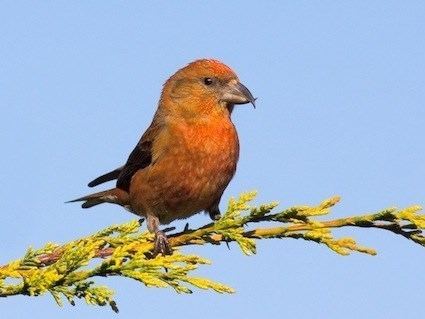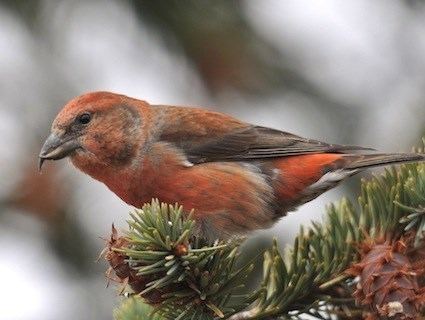Order Passeriformes Genus Loxia Higher classification Crossbill | Phylum Chordata Family Fringillidae Scientific name Loxia curvirostra Rank Species | |
 | ||
Lower classifications Newfoundland crossbill, Southern Appalachian Red Crossbill | ||
Red crossbills singing and feeding
The red crossbill (Loxia curvirostra) is a small passerine bird in the finch family Fringillidae, also known as the common crossbill in Eurasia. Crossbills have distinctive mandibles, crossed at the tips, which enable them to extract seeds from conifer cones and other fruits.
Contents
- Red crossbills singing and feeding
- Red crossbill finches yellowstone national park
- Description
- Breeding and irruption
- Taxonomy and systematics
- References

Adults are often brightly coloured, with red or orange males and green or yellow females, but there is wide variation in colour, beak size and shape, and call types, leading to different classifications of variants, some of which have been named as subspecies.

Red crossbill finches yellowstone national park
Description

Crossbills are characterized by the mandibles crossing at their tips, which gives the group its English name. Using their crossed mandibles for leverage, crossbills are able to efficiently separate the scales of conifer cones and extract the seeds on which they feed. Adult males tend to be red or orange in colour, and females green or yellow, but there is much variation.

In North America, nine distinct red crossbill variants (referred to as call types) differing in vocalizations as well as beak size and shape are recognized. Each call type evolved to specialize on different species of conifer.
Breeding and irruption

The red crossbill breeds in the spruce forests of North America, as well as Europe and Asia. Some populations breed in pine forests in certain areas of all three continents, and in North America, also in Douglas-fir. It nests in conifers, laying 3–5 eggs.
This crossbill is mainly resident, but often irrupts south when its food source fails. These irruptions led in the twentieth century to the establishment of permanent breeding colonies in England, and more recently in Ireland. This species forms flocks outside the breeding season, often mixed with other crossbills.
The first known irruption, recorded in England by the chronicler Matthew Paris, was in 1254; the next, also in England, appears to have been in 1593 (by which time the earlier irruption had apparently been entirely forgotten, since the crossbills were described as "unknown" in England). The engraver Thomas Bewick wrote that "It sometimes is met with in great numbers in this country, but its visits are not regular", adding that many hundreds arrived in 1821. Bewick then cites Matthew Paris as writing "In 1254, in the fruit season, certain wonderful birds, which had never before been seen in England, appeared, chiefly in the orchards. They were a little bigger than Larks, and eat the pippins of the apples [pomorum grana] but no other part of them... They had the parts of the beak crossed [cancellatas] by which they divided the apples as with a forceps or knife. The parts of the apples which they left were as if they had been infected with poison." Bewick further records an account by Sir Roger Twysden for the Additions to the Additamenta of Matt. Paris "that in the apple season of 1593, an immense multitude of unknown birds came into England ... swallowing nothing but the pippins, [granella ipsa sive acinos] and for the purpose of dividing the apple, their beaks were admirably adapted by nature, for they turn back, and strike one point upon the other, so as to show ... the transverse sickles, one turned past the other."
Taxonomy and systematics
The genus name Loxia is from Ancient Greek loxos, "crosswise", and curvirostra is Latin for curved bill".
This species is difficult to separate from parrot crossbill and Scottish crossbill, both of which breed within its Eurasian range, as plumage distinctions from those two species are negligible, though the head and bill are smaller than in either of the other species. Care is needed in identification, especially in Eurasia, where the glip or chup call is probably the best indicator. The identification problem is less severe in North America, where only red crossbill and White-winged crossbill occur. However, there has been debate as to whether different call types should be considered separate species. For example, the South Hills crossbill, occurring in the South Hills and Albion Mountains in Idaho has been described as a new species (Loxia sinesciuris) because it shows a very low degree of hybridization with the red crossbill. There are also genetic differences between the call type populations. Nevertheless, few ornithologists have chosen to give these forms species status.
Some large-billed, pine-feeding populations currently assigned to this species in the Mediterranean area may possibly be better referred to either parrot crossbill or to new species in their own right, but more research is needed. These include Balearic crossbill L. curvirostra balearica and North African crossbill L. curvirostra poliogyna, feeding primarily on Aleppo pine (Pinus halepensis); Cyprus crossbill L. curvirostra guillemardi, feeding primarily on European black pine (Pinus nigra); and an as-yet unidentified crossbill with a parrot crossbill-size bill feeding primarily on Bosnian pine (Pinus heldreichii) in the Balkans. These populations also differ on plumage, with the Balearic, North African and Cyprus races having yellower males, and the Balkan type having deep purple-pink males; this however merely reflects the differing anthocyanin content of the cones they feed on, as these pigments are transferred to the feathers.
